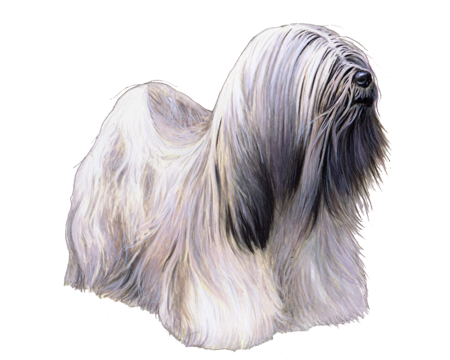
Russian Tsvetnaya Bolonka
The Russian Tsvetnaya Bolonka is a charming, curious, clever, and spirited breed. These little dogs have big hearts and make great family pets. Despite all of their positive qualities, this toy breed remains rare.
Interested in discovering if your dog is a Russian Tsvetnaya Bolonka?
Check out Wisdom Panel's DNA tests.

Russian Tsvetnaya Bolonka Traits
General Appearance
Bolonki are small, balanced dogs that are longer than tall. The breed is known for its graceful movements, sweet, alert expressions, and outgoing personalities.
Coat and Coloring
The Russian Tsvetnaya Bolonka has a double coat. The undercoat is well developed. The outer coat is dense, thick, and soft and forms large curls that fall naturally. The breed standard requires Bolonki to have beards and mustaches. Both fashionable and functional, bows often hold up the hair on the tops of their heads.
Initially, all Bolonki were black—presumably to hide dirt at a time when shampoo was scarce. The current breed standard permits all colors except white (but white markings on the toes and chest are allowed). Black remains one of the most common colors along with brown, gray, red, and wolfgray with fawn, silver, and tan markings.
Distinctive Physical Traits
Bolonki have compact bodies with broad, well-muscled backs, deep chests, and short, level loins. They have medium-sized, rounded eyes that are dark brown or hazel. Their small, high set ears are carried drooping or folded, and their noses are either solid black or match their coat colors. Bolonki have medium-length, high set tails that are carried over their backs or off to the side.
Russian Tsvetnaya Bolonka Temperament
Bolonki are sweet, even-tempered dogs that are affectionate with their families and friendly toward strangers. Children love them for their small size and spirited but easy going personalities (and Bolonki love them right back). These charming dogs can turn strangers into friends and transform those unfamiliar with the breed into enthusiastic fans.
Although Bolonki are quick to alert their owners if something seems amiss, they are not vocal dogs and, with training, will not be a constant barker. This intelligent breed adapts well to many different situations, including apartment living.


Russian Tsvetnaya Bolonka History
The Russian Tsvetnaya Bolonka hails from Saint Petersburg and Moscow. During the 1700s, Louis XIV of France bestowed these small dogs' ancestors as gifts to Russian nobles. The breed, better known as Bolonka (Bolonki, when plural), was developed through by crossbreeding companion dogs such as Bichon Frise, Pekingese, and French Bolognese with Russian street dogs. The result was the intelligent, outgoing Russian Tsvetnaya Bolonka.
Russia was known for its working dogs, not small breeds like Bolonki, which were considered unnecessary extravagances. But things changed in the 1960s when Khrushchev came to power. Scarce housing and sharp increases in apartment living rendered large working dogs obsolete in Russian cities, giving rise to the demand for smaller breeds.
Interest in the Bolonka has increased steadily in Russia, where the breed has earned its keep as a companion and guardian. Promises to maintain the breed standards led the Russian Kennel Federation and the National Russian Bolonka Club to allow dogs to be exported and bred in other countries.
Russian Tsvetnaya Bolonka Care
Nutrition
Bolonki require a high-quality dog food that's appropriate for their life stage (e.g., puppy, adult, senior). A diet formulated specifically for small breed dogs is a good option to consider.
All dogs run the risk of obesity if they eat too many calories. Portion out their food with a measuring cup and limit treats to no more than 10% of their daily calories to prevent overfeeding.
Grooming
Maintaining Bolonki's beautiful coats requires regular grooming. Brush their hair with a wide-toothed comb several times per week to keep it from becoming tangled or matted. Bolonki also need their faces, mustaches, and beards washed daily. Tying their hair up in a bow on top of their heads can keep it from falling in their eyes, where it can cause irritation.
In addition to regular nail trims and ear cleanings, dental care is important, too. Start a regular dental care routine that includes at-home teeth brushing and professional cleanings when Bolonki are puppies to ensure good oral hygiene throughout their lives.
Exercise
The Russian Tsvetnaya Bolonka is more lapdog than athlete. Still, these dogs enjoy going for walks around the block, trips to the dog park, or exploring their fenced yards. Games like fetch or hide-and-seek can also be sufficient to help these little dogs burn energy.
Provide opportunities for mental and physical stimulation, such as games and puzzle toys, to keep this intelligent breed engaged and active. Bolonki may also enjoy activities such as competitive obedience, rally, tracking, or agility.
Training
Bolonki are intelligent and independent, a combination that can make training a challenge. A consistent training program that incorporates positive reinforcement and rewards can provide the right foundation to teach this toy breed basic commands (and new tricks). Regular socialization is also important to make Bolonki feel comfortable with unfamiliar people, pets, and places.
Russian Tsvetnaya Bolonka Genetic Health Conditions
-
Chondrodystrophy (CDDY) and Intervertebral Disc Disease (IVDD) Risk
Chondrodystrophy (CDDY) is a skeletal disorder characterized by shortened limbs and abnormal early degeneration of the spinal discs, or intervertebral disc disease (IVDD), which predisposes to disc herniation.
Knowing if your Russian Tsvetnaya Bolonka is a carrier or at-risk for these conditions can help you and your veterinarian plan for your pup’s lifelong care. With Wisdom Panel™ Premium, you can get results for over 200 genetic health tests.
Breed Group
Companion
This group consists of dogs typically bred for the specific purpose of human companionship, and many are popular pets because of their gentle nature. They became more common as the concept and luxury of dogs as pets prevailed.
Resources
https://www.akc.org/dog-breeds/russian-tsvetnaya-bolonka/
http://tsvetnayabolonkaclub.homestead.com/rkfstandard.html
Reviewed July 26, 2020 by Cindy Elston, DVM, MPH



























_Color.png)





















